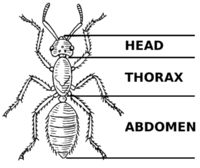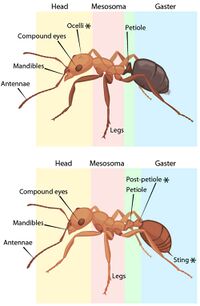Formicidae: Difference between revisions
No edit summary |
No edit summary |
||
| Line 17: | Line 17: | ||
Most ant species found will be either red, brown, or black in color. [2] They can range anywhere from 1/16 of an inch long (Crazy Ant) [4], up to 1.6 inches long (Dinoponera, thought to be the biggest ant species in the world, found in South America). [5] Most common ants, however, are 1/16 to 1/2 an inch long. [6] Their bodies are broken down into three main segments (Figure 1), with the thorax and the abdomen being further broken down into three more subsegments (Figure 2). | Most ant species found will be either red, brown, or black in color. [2] They can range anywhere from 1/16 of an inch long (Crazy Ant) [4], up to 1.6 inches long (Dinoponera, thought to be the biggest ant species in the world, found in South America). [5] Most common ants, however, are 1/16 to 1/2 an inch long. [6] Their bodies are broken down into three main segments (Figure 1), with the thorax and the abdomen being further broken down into three more subsegments (Figure 2). | ||
===Head=== | ===Head=== | ||
The head of an ant contains the mouth, five eyes, two antennae, and two strong jaws. Of the five eyes, two (located on the front of the head) are compound eyes that are good for acute movement but do not allow for high-resolution images, while the other three (located on the top of the head) are simple eyes that detect changes in light. The two antennae are sensory organs that allow ants to detect chemicals, air currents, and vibrations, as well as receive signals through touch. The strong jaws are used for defense, carrying food, and constructing nests. [1] | |||
===Thorax=== | ===Thorax=== | ||
The thorax is the middle part of an ant's body. It is powerful and muscular, with each of an ant's six legs attached to it. If an ant develops temporary wings, they will be attached to the thorax as well. [7] | |||
===Abdomen=== | ===Abdomen=== | ||
===Mesosoma=== | ===Mesosoma=== | ||
===Petiole=== | ===Petiole=== | ||
| Line 44: | Line 47: | ||
[6] https://www.terminix.com/ants/#:~:text=Their%20legs%20and%20antennae%20are,if%20they%20invade%20your%20home. | [6] https://www.terminix.com/ants/#:~:text=Their%20legs%20and%20antennae%20are,if%20they%20invade%20your%20home. | ||
[7] https://animals.mom.com/ants-body-parts-5992.html | |||
Revision as of 12:18, 21 April 2023
Overview

Formicidae is a family, containing ants, that belongs to the order Hymenoptera, which contains the ants close relatives bees and wasps. It's estimated that there are 22,000 species of ants, with roughly 15,000 of these species being classified. [1] They are incredibly numerous, being found everywhere in the world except for Antarctica as well as Greenland, Iceland, Hawai'i, and some Pacific Islands that don't have native species. [2] The mass of all the ants in the world is said to be greater than the mass of all birds and mammals combined, with an estimated human-to-ant ratio of 1:2,500,000. [3]
Taxonomy
- Kingdom- Animalia (Animals)
- Phylum- Arthropoda (Arthropods)
- Class- Insecta (Insects)
- Order- Hymenoptera (Ants, Bees, and Wasps)
- Infraorder- Aculeata (Ants, Bees, and Wasps)
- Superfamily- Formicoidea (Ants)
- Family- Formicidae (Ants)
- Superfamily- Formicoidea (Ants)
- Infraorder- Aculeata (Ants, Bees, and Wasps)
- Order- Hymenoptera (Ants, Bees, and Wasps)
- Class- Insecta (Insects)
- Phylum- Arthropoda (Arthropods)
Description


Most ant species found will be either red, brown, or black in color. [2] They can range anywhere from 1/16 of an inch long (Crazy Ant) [4], up to 1.6 inches long (Dinoponera, thought to be the biggest ant species in the world, found in South America). [5] Most common ants, however, are 1/16 to 1/2 an inch long. [6] Their bodies are broken down into three main segments (Figure 1), with the thorax and the abdomen being further broken down into three more subsegments (Figure 2).
Head
The head of an ant contains the mouth, five eyes, two antennae, and two strong jaws. Of the five eyes, two (located on the front of the head) are compound eyes that are good for acute movement but do not allow for high-resolution images, while the other three (located on the top of the head) are simple eyes that detect changes in light. The two antennae are sensory organs that allow ants to detect chemicals, air currents, and vibrations, as well as receive signals through touch. The strong jaws are used for defense, carrying food, and constructing nests. [1]
Thorax
The thorax is the middle part of an ant's body. It is powerful and muscular, with each of an ant's six legs attached to it. If an ant develops temporary wings, they will be attached to the thorax as well. [7]
Abdomen
Mesosoma
Petiole
Gaster
Common Species in the Northeastern USA
Life Cycle
Effects on Soil
References
[1] https://en.wikipedia.org/wiki/Ant